Smart packaging of fresh fruit is an emerging technology to reduce waste and maintain consumer health and safety. Intelligent packaging systems also help to prolong the perishability of perishable food during mass transportation and storage, which is otherwise difficult to regulate.
Utilizing these evolving technologies in fruit packaging can lead to many positive consequences, including improved fruit quality, reduced waste, and improved general health. In this study, we examine the role of intelligent packaging in fruit packaging, the latest state of the art, challenges and perspectives.
First, we discuss the motivation behind monitoring and maintaining fruit quality, followed by the background of the fruit development process, the factors used to determine fruit quality, and the classification of intelligent packaging technologies. Next, we discuss typical freshness sensors for packaged fruits, including direct and indirect freshness indicators.
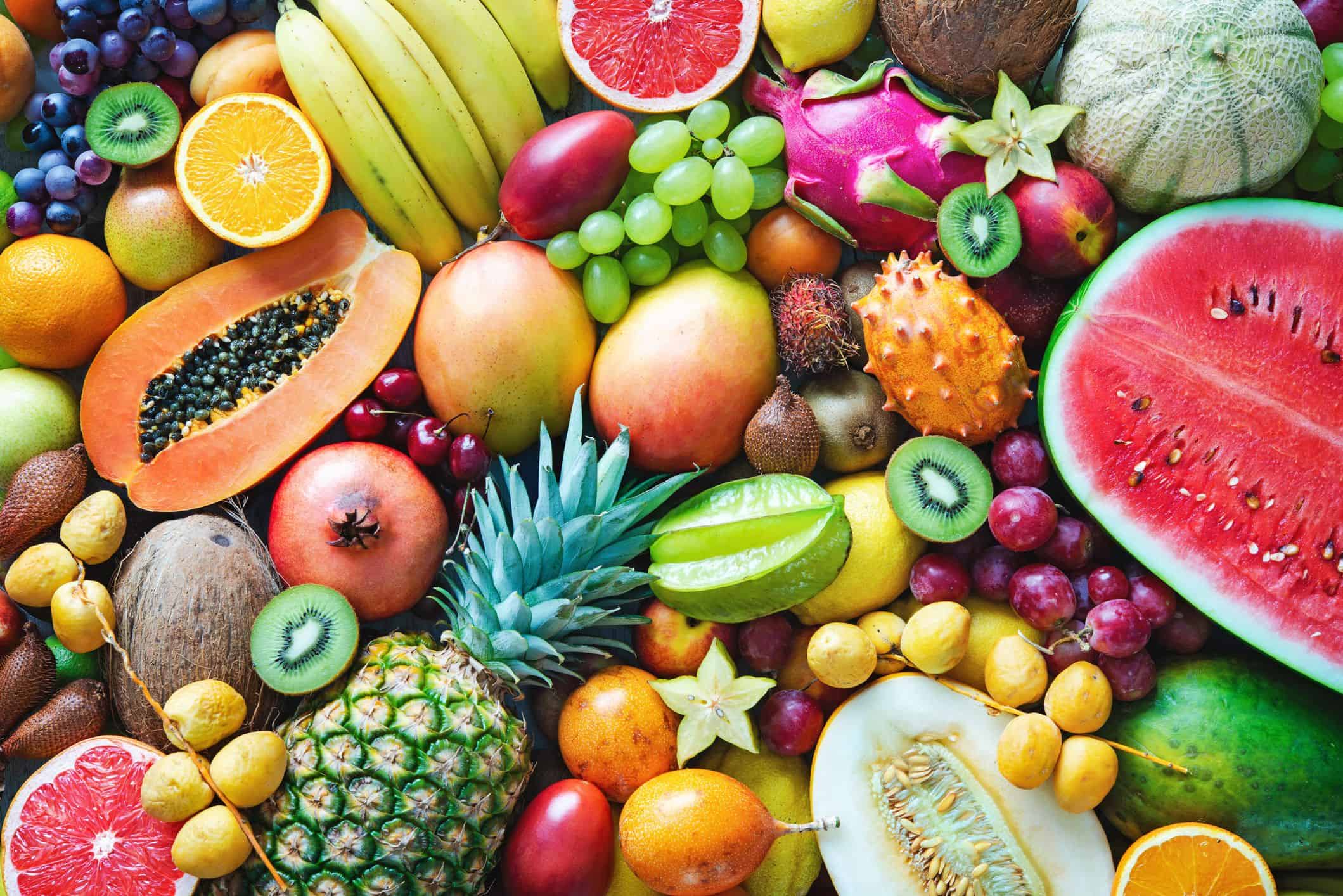
Current civilization:
Today’s civilization needs innovation in the production, storage and distribution of food to solve the problems of hunger that still afflict several parts of the world. Food production with the help of science and technology is growing rapidly due to increasing demand. However, there are many differences between different countries. There is a permanent shortage of food in them and some other countries where food is wasted quickly.
Next, we provide examples of possible intelligent packaging systems and sensors that can be used to monitor fruit quality. This is followed by several strategies to reduce premature fruit rot and active packaging technologies. Finally, we discuss the prospect of using smart packaging to monitor fruit quality, along with related challenges and prospects.
Despite the differences, all communities share a common need for better ways to prevent unnecessary food spoilage. Also, the global food market is more in demand than ever before for fresher, higher quality food at a reasonable cost.
With a global population of 7.6 billion producing more than 1.3 billion tons of food waste and a projected population of 9.6 billion by 2050, current food processing practices and technologies need to be evaluated and improved.
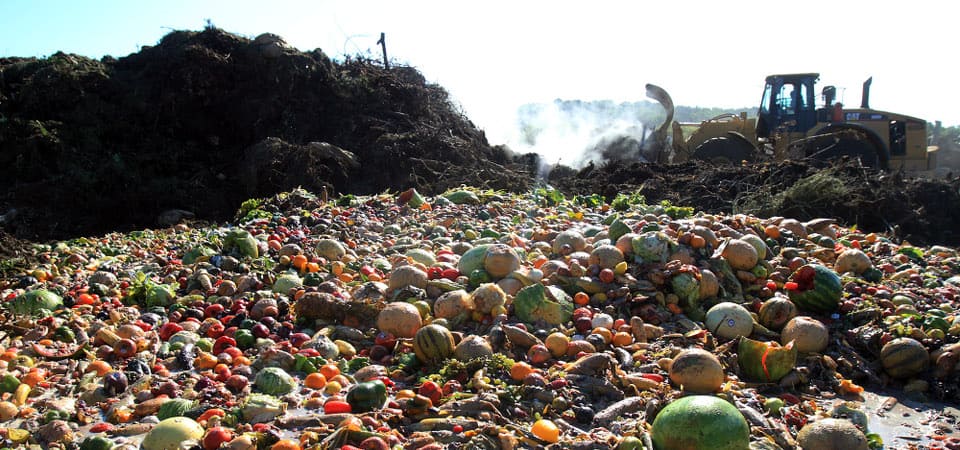
Learn more about fruits and vegetables!
Fruits and vegetables are living biological bodies that have a respiratory system and continue during their life processes and even after harvest.
By breathing, fruits and vegetables receive oxygen and produce carbon dioxide. Therefore, moving and packing fruits is key to maintaining their freshness until they reach the consumer table. One of the main sources of premature spoilage in perishable fruits is during transportation and storage. This is a key issue for fresh fruits, which are poorly monitored after harvest, treatment and packaging.
Fruits are an essential part of the human diet. Because they contain vitamins, minerals, antioxidants, fiber and many other essential nutrients. Most countries in their dietary recommendations recommend the daily consumption of fruits and vegetables and emphasize the importance of access to good quality products.
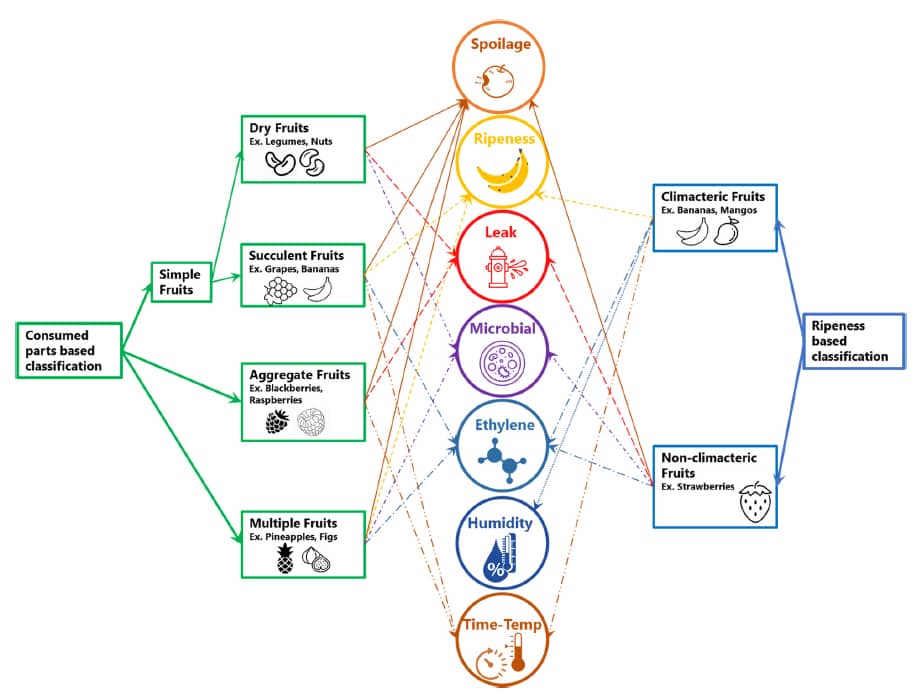
Consumer health and safety are also important factors in paying attention to fruit quality. Many harmful microorganisms can infect new products, especially through poor management and processing. Most of these pathogens are collected during transportation and storage due to defective packaging techniques.
Given the potential severity of these risks, regulations on fresh fruit are strict, especially in developed countries. Vendors are taking precautions, such as throwing away food that has passed its “expiration date,” which the USDA says is not a true indicator of spoiled food. Products are often still viable after this date, meaning that large quantities of unsold food are unnecessarily discarded.
The goal of conventional packaging is to limit the harmful environmental exposure of fruits and fruit products, but often not enough. It is difficult to monitor and maintain peak quality at all stages of food processing. In most cases, the fruit may not have a warning of problems before it is too late.
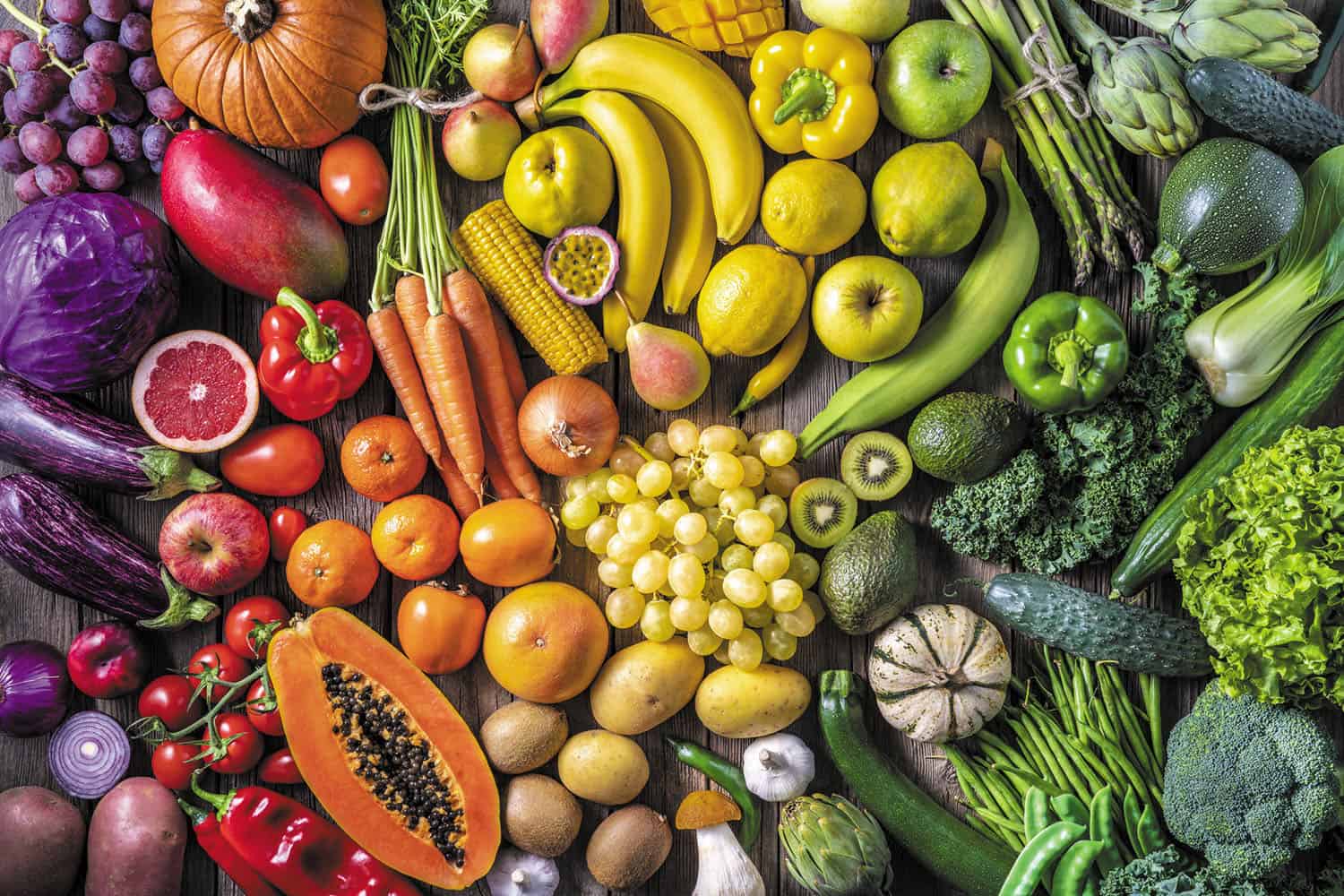
Smart fruit packaging was created!
To meet this need in product processing, along with other food processing innovations, novelty sensors and intelligent packaging systems have been developed to monitor fruits. Sensors or markers of fruit freshness can detect and report fruit quality status such as freshness, ripeness, leakage, microbial pathogens and emissions associated with the safety of the food consumed. Thus, novelty sensors can be defined as sensors or markers on the package that can sense the freshness of food related to the indoor or outdoor environment and advise on food quality and safety.
Intelligent packaging systems, on the other hand, provide methods for passive and active packaging solutions. Built-in sensor technology that can detect changes in fruit health and environmental conditions that affect quality.
Smart packaging allows you to use real-time monitoring until the product is delivered to the customer. In fact, intelligent packaging systems can be used to create reaction systems that can reduce the condition of corruption and increase the shelf life of perishable items. While still in its infancy, the numerous opportunities for applications of intelligent packaging technology in the prevention of fruit spoilage are a key impetus for further research and development.
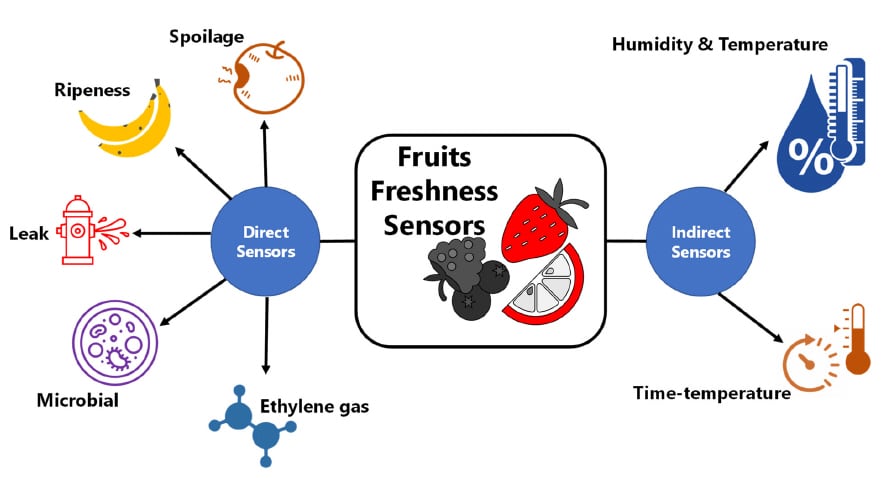
Numerous studies have been conducted on the use of novelty sensors and intelligent packaging systems in the food and beverage industries, as well as their application in water quality monitoring. Several studies have also focused on monitoring the freshness and controlled packaging of meat and animal products.
However, there have been very few studies that have focused on monitoring and feeling the freshness of fruits and fruit products. In fact, many of these studies have focused on product freshness, with less attention paid to fruits and fruit products.
The high rate of fruit spoilage and the increasing prevalence of fruit-related diseases require a comprehensive study of the latest technologies and future research trends to monitor the freshness and intelligent packaging of fruits within packaging.
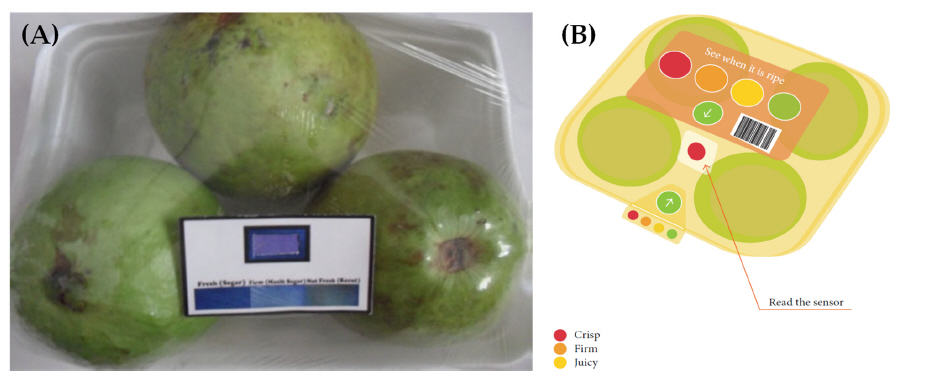
Refreshment sensors and intelligent packaging systems for monitoring fruits can also have high potential for the presence of emerging contaminants such as micro-plastic contaminants that migrate from plastic packages. Also, a comprehensive review of novelty sensors and intelligent systems technologies for fruit monitoring reveals current challenges and the vision of technology roadmaps toward greater commercial use of intelligent packaging in the fruit packaging industry.
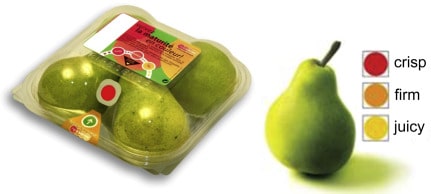
A variety of intelligent packaging of fruits and vegetables
At present, the methods and technologies used in intelligent packaging for fruits are the same as for packaging different types of meat. So if you’re interested in learning about these technologies, you can read our Smart Meat Packaging article, the section on the types of smart packaging used for meat.
But Vira team has prepared a complete and practical table that briefly introduces you to the types of smart packaging used for fruits and vegetables.
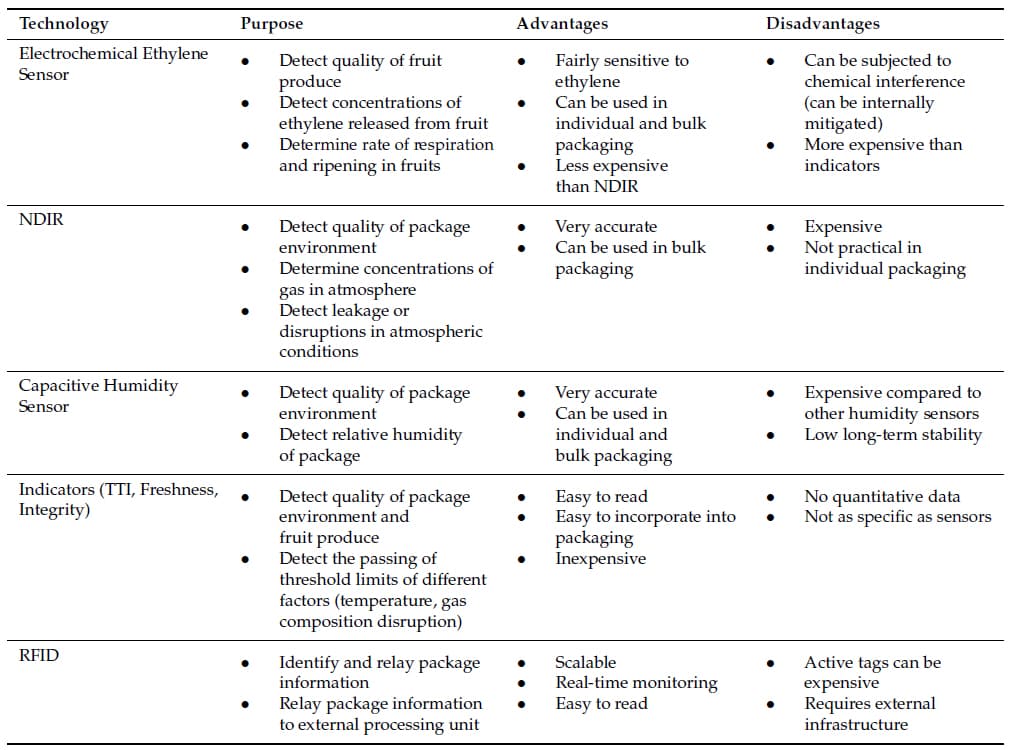
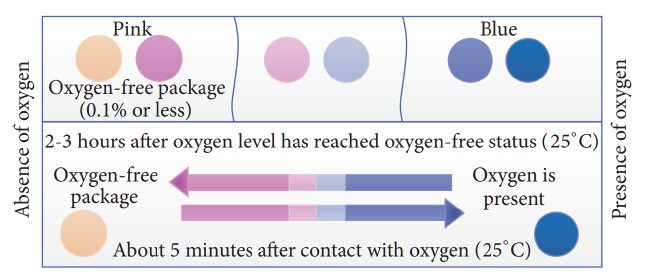
Active systems in intelligent fruit packaging
Ethylene cleaning for active packaging:
While the fruit is still being transported or stored, it is recommended to keep the amount of ethylene as low as possible. When values above the acceptable level are detected by sensors, ethylene scavengers can be released to reduce the effects that ethylene can normally have.
Scavengers are compounds that react with the target compound to absorb it or turn it into a harmless compound. In the case of ethylene, potassium permanganate is an ideal choice because it oxidizes ethylene in stages and its net result is carbon dioxide, water and manganese dioxide.
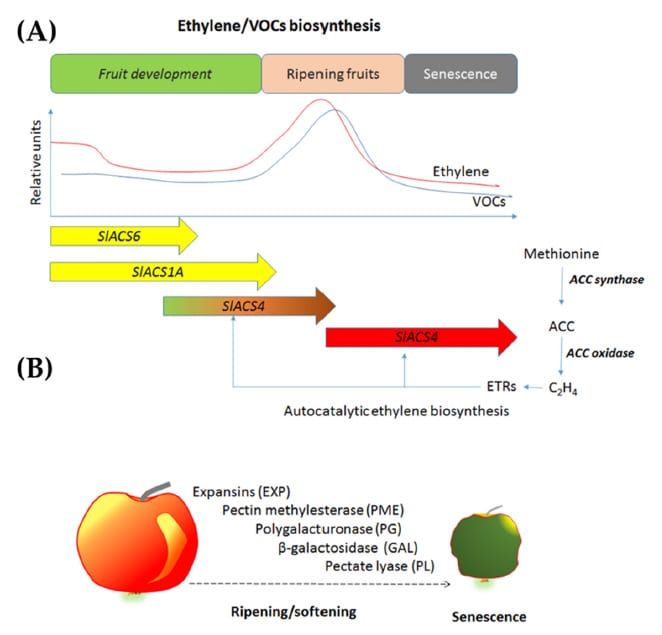
(B) The main enzymes involved in cell wall destruction during fruit ripening and aging.
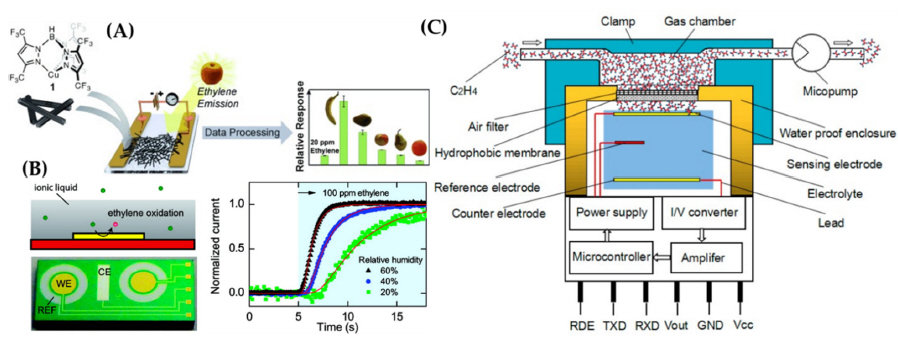
(B) Schematic diagram of the ethylene assay mechanism
(C) Schematic diagram of an intelligent electrochemical ethylene sensor
Carbon dioxide emitter for active packaging:
Unlike ethylene scavengers used in active packaging technology to reduce the amount of ethylene gas that fruits are exposed to, carbon dioxide emitters increase the amount of compound, especially carbon dioxide in the packaging. An example of how this technology is implemented is by using the reaction between sodium bicarbonate and water, which produces carbon dioxide to slow down fruit respiration.
Moisture absorber for moisture control:
Moisture absorbers are compounds that are commonly packaged with the product and used to control moisture levels. These compounds absorb excess moisture in the packaging atmosphere, resulting in a more controlled environment.
Silica gels, which have been shown to absorb 35% of their weight by weight, and calcium oxide are examples of these compounds used in the packaging of dry foods such as fresh fruit.
Hydrogen sulfide fumigation for active packaging:
There is compelling evidence for the use of hydrogen sulfide (H2S) in physiological processes in plants, including seed germination, root organization, abiotic stress tolerance, and aging of cut flowers. However, the use of H2S in regulating the ripening and aging of post-harvest fruits is becoming an emerging technique. For example, in one study, the effect of H2S on postharvest persistence and antioxidant metabolism in strawberry fruits was investigated.
Dose-dependent incense with H2S was found to extend the shelf life of strawberry fruits. Different concentrations of H2S were used for strawberry incense and the results showed that the caries index was significantly lower, fruit firmness was higher, respiratory rate was lower and polygalacturonase activities were changed compared to the control group.
This study also showed that higher activities of catalase, guaiacol peroxidase, ascorbate peroxidase and glutathione reductase and lower lipoxygenase activities were obtained with H2S treatment compared to untreated controls. In addition, H2S helped reduce malondialdehyde, hydrogen peroxide, and superoxide anion to lower levels compared to control fruits during storage. These results suggest that H2S may play an antioxidant role in prolonging the shelf life of strawberry fruits and potentially other similar fruits.
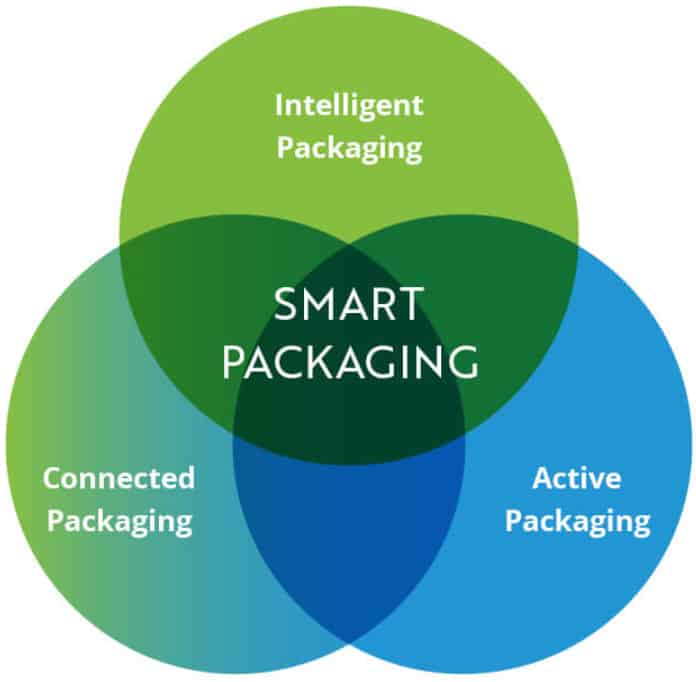


perfect
Thank you. that’s kind of you.